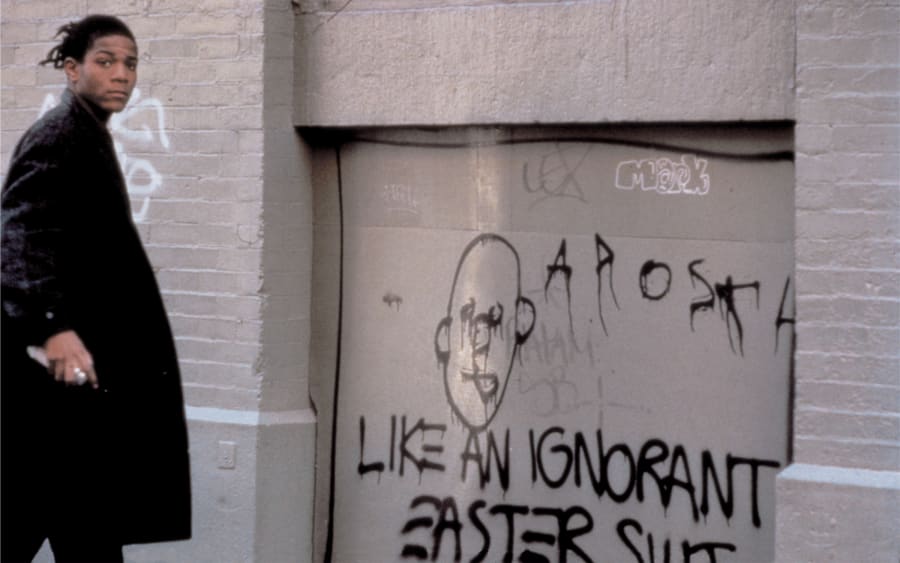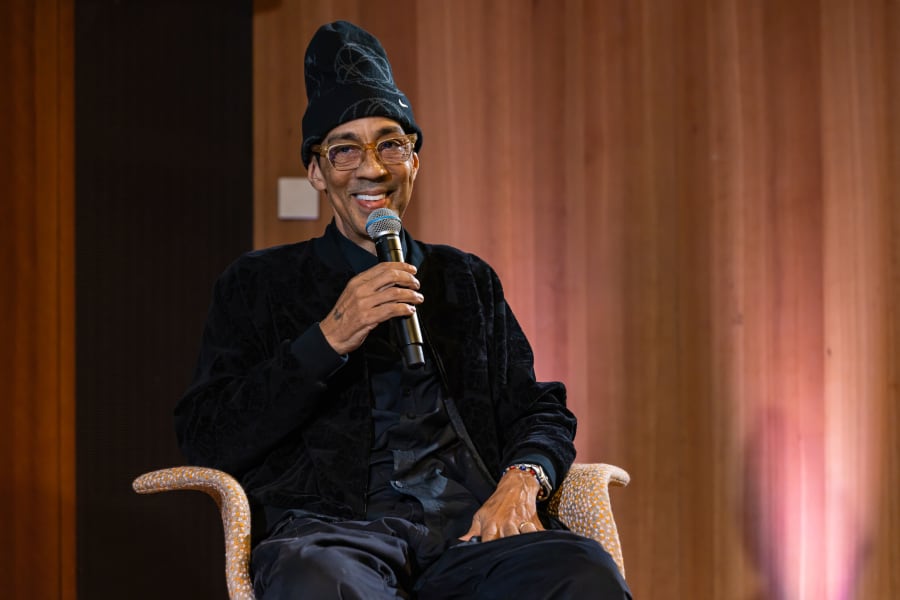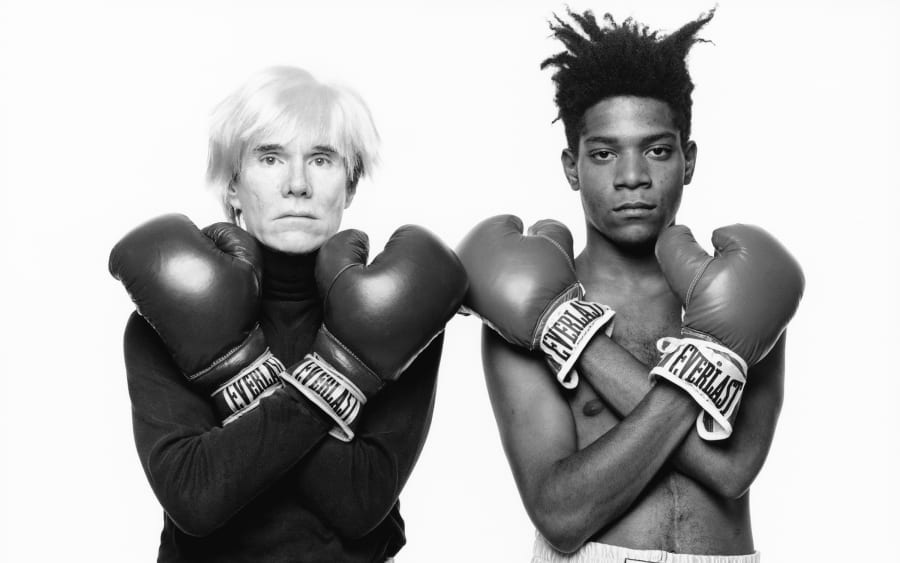In collaboration with Numéro art
During the final years of his life, he was rarely seen without a mask. A master of graffiti, a painter, sculptor, rapper, and creator of costumes, objects, and accessories of all kinds, Rammellzee (1960–2010) remained, until his death, as mysterious as he was unclassifiable – a figure whose genius we are only now beginning to grasp.
Fifteen years after his untimely death, the Palais de Tokyo in Paris is staging his first retrospective in France, running until May 11. With around 100 works, including rare pieces never shown before, this two-part exhibition in Paris will be followed in 2026 by a further installment at Capc Musée d’art contemporain in Bordeaux, thereby allowing an in-depth exploration of the legacy of this complex and eminently singular character.
From his beginnings in 1970s New York, Rammellzee distinguished himself by creating, but also theorizing, his own language. Describing himself as a ‘Gothic soldier’, the artist turned words and letters into weapons, waging a war against those in power who control us through language. He emptied words of their familiar meanings, injecting them with new, mysterious significances. In 1979, aged just 19, he adopted the pseudonym RAMMΣLLZΣΣ, and produced his own manifesto, in which he theorized two philosophies: ‘Gothic Futurism’ and ‘Ikonoklast Panzerism’, born from his obsession with Gothic iconography and typography on the one hand, and science fiction and horror imagery on the other. ‘Rammellzee grew up in Far Rockaway, Queens in New York,’ explains Hugo Vitrani, curator of the retrospective at the Palais de Tokyo. ‘He lived next to the overground subway arches, which he saw as doors to the future.’ And which would become his first playground.
Fascinated early on by copyist monks, the artist often cited medieval illuminated manuscripts as his ultimate source of inspiration. ‘For him, the first graffiti was medieval writing with Cistercian art,’ explains Alain-Dominique Gallizia, a specialist in graffiti on canvas and collector of the artist’s work.
Thus, from subway walls to canvas or cardboard, Rammellzee stylized his letters by playing with colors and textures using spray paint. Instinctively, the New Yorker mixed them with other symbols to form ‘equations’, a mathematical term he liked to use, since equations, unlike language, are ‘universal’. (His own pseudonym came from the formula ‘RAM times elevation to the power of Z.’) With disparate elements on the same plane, including paint splatters and arrows – his signature style – combined with vivid colors, a sense of rhythm, and dynamic lines, his works recall the compositions of the great figures of Modern abstraction like Vassily Kandinsky or Joan Miró. Thanks to the singularity and richness of his style, Rammellzee became one of the great masters of ‘wildstyle’ – the most complex form of graffiti, characterized by very free, even chaotic compositions, where letters are deformed almost to the point of illegibility.
With his fellow artists, DONDI, PHASE 2, and FUTURA 2000, Rammellzee enjoyed some time in the spotlight in 1980s New York, presenting his work in several exhibitions of the new art form emerging with graffiti. It was during this period that he met a certain Jean-Michel Basquiat. Together with the artist Toxic, they formed a trio. In 1983, Basquiat painted Hollywood Africans, recalling the importance of his two friends to his career: On a chick-yellow background, the young artist represented himself alongside Toxic and Rammellzee.
But Basquiat’s relationship with Andy Warhol would spell the end of his friendship with Rammellzee: From then on, the young prince of painting would be put on a pedestal by his elder and courted by the predominantly white contemporary art world, to the point of overshadowing those who had helped shape him. Until his death, Rammellzee would harbor resentment against his now ‘enemy brother,’ but especially against Warhol, whom he considered uninteresting.
While the shifts in contemporary art gradually distanced Rammellzee from galleries and the market, he continued, in his Tribeca studio – or his ‘battle station’, as he called it – to experiment and diversify his techniques. Accustomed from a very young age to working in the darkness of New York subway tunnels, he used phosphorescent paints, enriching his fascinating compositions with both daytime and nighttime readings, in which cryptic elements were revealed.
Like the New Realists, such as Daniel Spoerri, Rammellzee attached to his supports various salvaged elements found around the city, including fragments of fans, decorated headboards, typewriter keyboards (a way of reminding us that he was a writer above all), and carpet. He fixed everything with an abundant – and unsafe – use of glue and epoxy.
At the Palais de Tokyo, visitors can discover the astonishing bracelets, never exhibited until now, that the artist made using stones, beads, and chains, thanks to skills acquired during jewelry courses, but also from his training as a dental prosthetist. Other particularly striking inclusions in the show are the ‘Garbage Gods’ he began to create in the 1990s: extravagant costumes, which he wore during musical performances. With cyclops eyes, threatening masks, samurai armor, kimonos, and even sneakers, the dozens of characters allowed him to slip freely into taking on different personalities, in the same way he transformed his voice by using a vocoder on his tracks.
In 2010, the artist passed away, due to heart disease, his health having been damaged by constant exposure to toxic materials as well as addiction issues. Since then, the art world seems to be gradually resurrecting his reputation: In New York, after appearing in the group exhibition ‘Printin’ at the Museum of Modern Art in 2012, Red Bull Arts dedicated a major retrospective to him in 2018, and a thick monograph was published by Rizzoli in 2024 with texts by his friends Jim Jarmusch and FUTURA 2000, among others. Several galleries such as Jeffrey Deitch in Los Angeles and Galerie Ziegler in Zurich have also presented his work in recent years, continuing to write the story of the man who wanted to ‘make letters fly.’
This article is part of an ongoing editorial collaboration with Numéro Art. You can read the original article here.
‘ALPHABETA SIGMA (Side A). RAMMELLZEE’ until May 11, then June 13 – September 7 at the Palais de Tokyo, Paris. ‘Side B’ is at Capc Musée d’art contemporain in Bordeaux, March 12 – September 20, 2026.
The RAMMELLZEE estate is represented by Jeffrey Deitch Gallery (New York, Los Angeles).
Matthieu Jacquet is a journalist and art critic writing for Numéro, Numéro art and Geste/s.
English translation: Art Basel.
Caption for header image: Rammellzee © Mari Horiuchi. Courtesy of Red Bull Arts New York and Rammellzee Estate.
Published on April 24, 2025.


